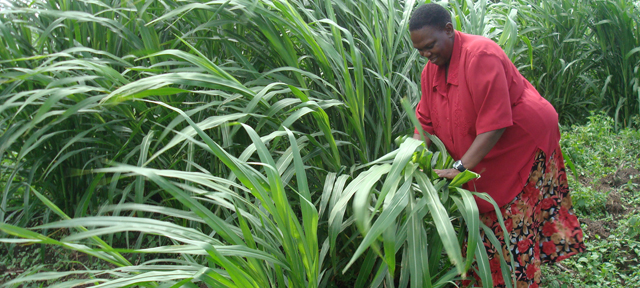 Napier grass cultivation in East Africa has been on an impressive rise in the last two decades as more farmers delve into dairy farming and as the dairying move from extensive to zero grazing and prices of commercial feeds skyrockets. But with the systemic growth has come a catalogue of woes from diseases to prohibitive market prices for the grasses which has now threatened the other 100 million East African livestock that relies on the grass.
Napier grass cultivation in East Africa has been on an impressive rise in the last two decades as more farmers delve into dairy farming and as the dairying move from extensive to zero grazing and prices of commercial feeds skyrockets. But with the systemic growth has come a catalogue of woes from diseases to prohibitive market prices for the grasses which has now threatened the other 100 million East African livestock that relies on the grass.
Nappier grass stunt disease has been the greatest threat, The disease was first observed in 2002, although it is thought to have been present for much longer, perhaps 30 years. Until a few years ago, the cause of the disease, which turns healthy thick leaves thin, yellow and weak, was unknown.
Agricultural staff speculated as to whether the cause might be a fungus, nematode damage or a nutrient deficiency, but without being sure was unable to offer advice to farmers. The breakthrough came in 2004 when Professor Phil Jones of the Global Plant Clinic, based at Rothamsted Research in the UK, identified the cause to be a phytoplasma. Similar to bacteria, these microbes live in the phloem (through which sugars are passed from leaves to storage organs) of infected plants.
The disease is spread in two ways. Over longer distances the primary means of spread is farmers themselves. Napier is vegetatively propagated, so farmers take either a slice of cane, or split a clump, in order to plant on. If unaware of the dangers, they can inadvertently introduce a diseased plant into their fields. Over shorter distances, such as between plants within a field, the disease is primarily spread by plant hoppers, small insects in the same family as crickets, cicadas and grasshoppers, which feed on the sugar-rich sap in Napier phloem, and can transfer the phytoplasma in their saliva in the process.
Despite their name, plant hoppers are quite sedentary, tending to live on just one plant. However, if that plant is cut down they will move to another. Hence in fields where leaves are regularly harvested, as typically occurs with farmers who use Napier for zero-grazing, the rate of insect movements, and therefore of disease spread, is much higher. Now that the cause of the disease has been recognised, promoting control measures among farmers has become a priority. Digging up infected plants and replacing them with healthy canes is the basic strategy.
The soil around infected plants cannot harbour the disease, so replanting in the same place is possible. The leaves of diseased plants can be safely fed to livestock - the phytoplasma does not persist in their manure - but roots should be burned or buried. Farmers are encouraged to identify clean planting material, either by selecting canes from parts of their land that are some distance from any infected plants, or by buying planting material from other areas where disease incidence is low. District agricultural offices have also been urged to create 'designated clean zones' where unaffected planting material can be obtained for distribution.
Although the message is relatively simple, bringing it to large numbers of farmers is a challenge. In mid 2000, Dr Eric Boa and Prof Jones from the Global Plant Clinic, and the Kenya Agricultural Research Institute (KARI), decided to trial a method known as Going Public, that has been successfully used to raise awareness about plant diseases in Bolivia and Uganda. Over a four day period Drs Sam Ajanga and Margaret Mullah ran 13 publicity events in five districts in western Kenya, meeting nearly 800 people.
The events, which were unscheduled and unannounced, were held at markets and road junctions and other gathering places. Samples of diseased and healthy plants were shown, control measures explained, and farmers questions answered. By carefully recording farmers' questions at each event, the team were able to refine their presentations, and by listening to farmers' comments they gained useful information about the extent of disease spread in the area. KARI have now earmarked funding so that the method can be scaled up through district agriculture offices, and are planning a training course for the publicity teams.
Over the longer term, Phil Jones believes regional collaboration will be vital to controlling the disease. Research priorities will include hunting for varieties of Napier that show resistance to both stunt and head smut, and developing a strategy for distribution of clean planting material. Researchers are already developing a mass screening test, and are holding a meeting at which training will be offered on vector insects and transmission studies - essential when looking for resistant plants - and on field diagnosis of the disease.
The meeting will also look beyond the specific threats to Napier, initiating the development of a regional strategy for forage crops, something that, given the recent expansion in the dairy industry, many scientists feel is long overdue.
















Comments powered by CComment